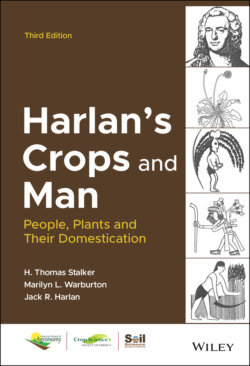Harlan's Crops and Man

Реклама. ООО «ЛитРес», ИНН: 7719571260.
Оглавление
H. Thomas Stalker. Harlan's Crops and Man
Table of Contents
List of Tables
List of Illustrations
Guide
Pages
Harlan’s Crops and Man: People, Plants and Their Domestication
Preface
1 Prologue: The Golden Age
Crop Evolution
The Hunter‐Gatherer Stereotype
What Do Gatherers Eat?
Grass Seeds (Potential Cereals)
Legumes (Potential Pulses)
Root and Tuber Plants
Oil Plants
Fruits and Nuts
Vegetables
Summary
Understanding Life Cycles of Plants
General Botanical Knowledge
Manipulation of Vegatation
Food Plants in Ritual and Ceremony
On Sharing the Bounty
Population Control and the Aged
Conclusions
References
2 Views on Agricultural Origins
Agriculture as Divine Gift
Domestication for Religious Reasons
Domestication by Crowding
Agriculture as Discovery
Agriculture by Stress
Agriculture as an Extension of Gathering
Domestication by Perception
A No‐Model Model
Geography of Plant Domestication
An Ecological Approach
Conclusions
References
3 What Is a Crop?
Definitions
Intermediate States
Baobab Tree
Acacia
Karité Tree
Oil Palm
Sago Palm
Ethiopian Oats
Additional Examples
A Short List of Cultivated Plants
Crops That Feed the World
References
Note
4 What Is a Weed?
Definitions
Intermediate States
Crop–Weed Complexes
Some Weed Adaptations
Weeds and History
Conclusions
References
Note
5 Classification of Cultivated Plants
Botanical Descriptions and Names
Problems of Formal Taxonomy
The Gene Pool System. Species
Primary Gene Pool (GP‐1)
Secondary Gene Pool (GP‐2)
Tertiary Gene Pool (GP‐3)
Subspecies
Species
Race
Subrace
Evolutionary Implications
Conclusions
References
Note
6 The Dynamics of Domestication
Domestication of Seed Crops. Cereals
Selection Associated with Harvesting
Selection Associated with Seedling Competition
Selection Associated with Crop–Weed Interaction
Differentiation–Hybridization Cycles
Other Selection Pressures
Other Seed Crops
Domestication of Vegetatively Reproduced Crops. Vegetative Propagation
Grafting
Ornamentals
Conclusions
References
Note
7 Space, Time, and Variation
Kinds of Patterns of Variation
Endemic
Semiendemic
Monocentric
Oligocentric
Noncentric
Noncentric Crops
Diffuse Origins
Microcenters
Landrace Populations
Implications for Plant Breeding
Conclusions
References
Note
8 The Near East
Introduction
Archaeological Prelude
A Note About Dating Archaeological Sites
Archaeological Sequence of Village Sites
Spread of Agriculture Out of the Nuclear Area
Recorded History
Conclusions
References
Note
9 Indigenous African Agriculture
Introduction
Archaeological Prelude
A Savanna Complex
Crop Competition and Distribution
Recorded History
Décrue Agriculture
Conclusions
References
Note
10 The Far East
Archaeological Prelude
Recorded History
Far Eastern Crops
Northern China
Eastern China Coastal Plain
Southern China
Asia and South Pacific
The Millets
Soybean
Rice
Sugarcane
Bananas and Plantains
Coconut
Orange
Mango
Yams
Hunter‐Gatherers of Japan
Plant Domestication in India
References
Note
11 The Americas
Archaeology
The Crops. Cereals
Beans
Tomato
Squash
Sunflower
Peppers
Peanut
Root and Tuber Crops
Sweet Potato
Cotton
Tobacco
Rubber
Fruits, Nuts, and Ornamentals
Forage Legumes
Indigenous Americans as Biochemists
Conclusions
References
Note
12 Epilogue : Who’s in Charge Here?
References
Note
WILEY END USER LICENSE AGREEMENT
Отрывок из книги
Third Edition
.....
Gathering peoples are evidently attracted to Leguminosae of various kinds. Whole pods may be used, as well as seeds only, pods only, or even the tissues inside the pods surrounding the seeds. Some legumes have edible tubers and others have leaves or young shoots suitable for pot‐herbs. Not infrequently the material harvested is poisonous and must be detoxified before use. Poisonous materials can be used for stunning fish, stupefying emus, or making poison arrows.
As with the Gramineae, certain genera appear frequently on plant lists and several distinct species of a given genus may be used in different parts of the world. Genera with wide distributions may be very widely used. For example, many species of Acacia are exploited in Australia, several are used in Africa and Asia, but only a few are used in the Americas. More species of Prosopis (mesquite) are used in the Americas, however, than in Africa, Asia, and Australia. Different species of Canavalia are harvested in Central and South America and in Southeast Asia and Australia. Vigna and Dolichos are widely exploited in Africa, Asia, and Australia while several species of Phaseolus are harvested in the Americas. Tephrosia spp. have been used for fish poisons on five continents.
.....